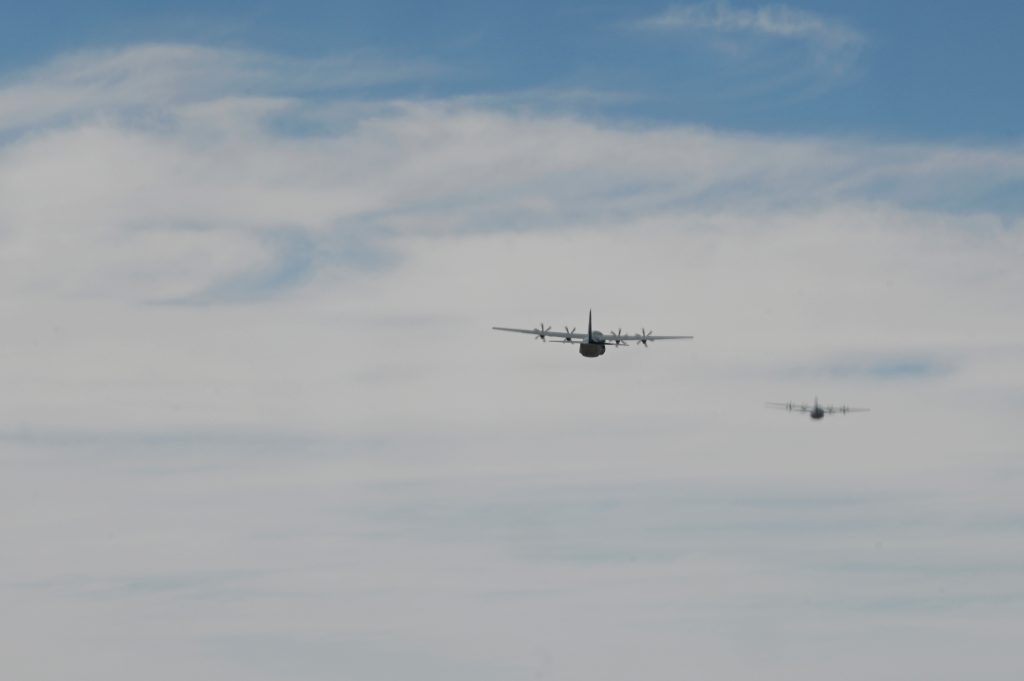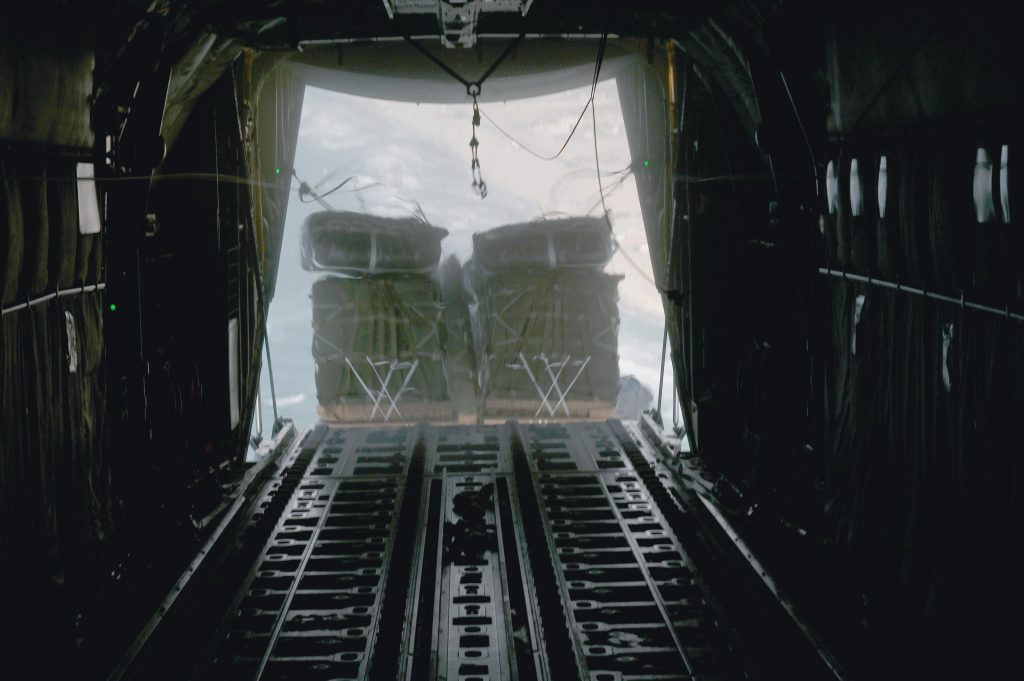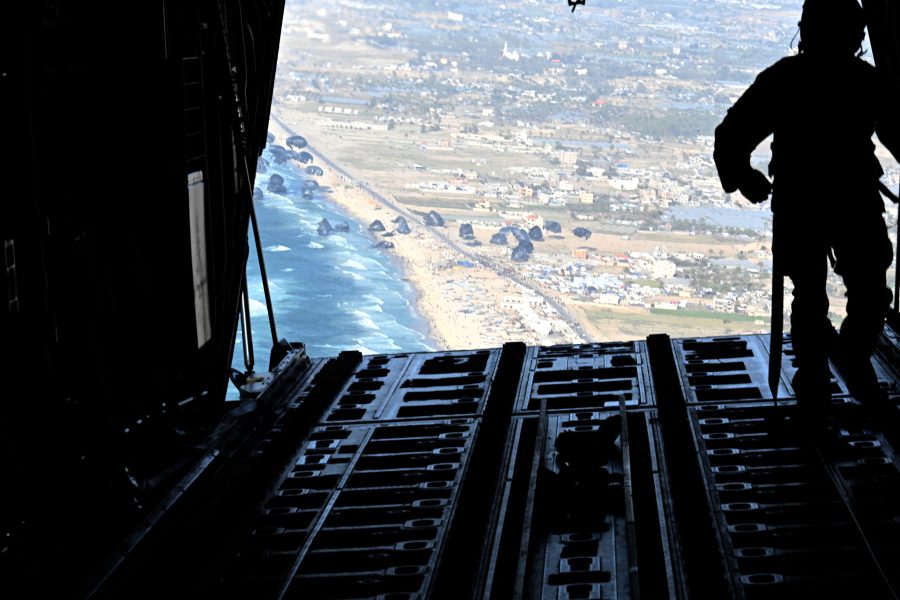Three U.S. Air Force C-130J Super Hercules aircraft conducted airdrops of humanitarian aid into Gaza on March 2, U.S. officials said.
The aircraft took off from Jordan and dropped 66 bundles—22 per aircraft—with over 38,000 meals ready to eat (MREs), senior administration officials told reporters. The U.S. airdrops occurred over southwest Gaza, a U.S. defense official told Air & Space Forces Magazine.
The U.S. C-130s were assigned to Air Forces Central (AFCENT), the USAF’s Middle East command. U.S. Central Command (CENTCOM) said in a statement the operation was carried out between 3 and 5 p.m. local time alongside Royal Jordanian Air Force C-130s.
“The combined operation included U.S. Air Force and RJAF C-130 aircraft and respective Army Soldiers specialized in aerial delivery of supplies, built bundles, and ensured the safe drop of food aid,” CENTCOM said. “U.S. C-130s dropped over 38,000 meals along the coastline of Gaza allowing for civilian access to the critical aid.”
“We are conducting planning for potential follow-on airborne aid delivery missions,” CENTCOM said in its statement.
“The fact that today’s airdrop was successful is an important test case to show that we can do this again in the coming days and weeks successfully,” a senior administration official added.
President Joe Biden announced March 1 the U.S. would conduct humanitarian airdrops into Gaza. During an Oval Office meeting with Italian Prime Minister Giorgia Meloni, Biden said the U.S. would join other countries in air-dropping assistance amid the Israel-Hamas war that has resulted in a humanitarian crisis.
“We need to do more and the United States will do more,” Biden said.
“The planning will be robust on this,” National Security Council spokesman John Kirby said March 1. “I know that we will learn from the first airdrops, and this will be a part of a sustained effort. This isn’t going to be one and done.”
“There’s few military operations that are more complicated than humanitarian assistance airdrops,” said Kirby, a retired Navy rear admiral. “This is a tough military mission to do because so many parameters have to be exactly right.”
The U.S. Air Force has previously flown C-17s filled with humanitarian aid into Egypt that was then delivered into Gaza in United Nations trucks via a land crossing. Kirby said the U.S. also hoped to deliver “large amounts” of aid by sea and expand land routes.
“I commend the outstanding efforts of our Airmen and Soldiers who made today’s airdrop a success and helped deliver more than 38,000 meals to civilians affected by the ongoing conflict in Gaza,” AFCENT commander Lt. Gen. Alexus G. Grynkewich said in a statement.
Jordan has been using C-130s to airdrop pallets of aid into Gaza for the past few days and has been joined by a growing coalition of countries that now includes aircraft from the United Arab Emirates, Egypt, France, and the U.S. A spokesperson for the Jordanian Embassy in Washington said two Jordanian C-130s took part in the March 2 operation with the USAF.
Biden said Israel is not allowing enough assistance into the beleaguered enclave during its war with Hamas.
“We’re going to insist that Israel facilitate more trucks and more routes to get more and more people the help they need,” Biden said. “No excuses, because the truth is aid flowing to Gaza is nowhere nearly enough now—it’s nowhere nearly enough. Innocent lives are on the line and children’s lives are on the line”

The Hamas-run Health Ministry in Gaza says over 30,000 people have died in the conflict. Civilians in Gaza have struggled to get food, water, medicine, and other essential supplies.
The Biden administration, along with Egypt and Qatar, has been working to broker a roughly six-week pause in fighting.
“Probably not by Monday, but I’m hopeful,” Biden said Feb. 29 when asked about progress on the ceasefire talks, the same day he spoke to Egyptian President Abdel Fattah Al-Sisi and Qatari Emir Sheikh Tamim Bin Hamad Al-Thani.
Dozens of civilians were killed racing to an aid convoy in Gaza City, which is in the north of the Strip, on Feb. 29. The Israel Defense Forces fired weapons during the incident, but the circumstances of the deaths are disputed.
Biden and the Egyptian and Qatari leaders “discussed planning to surge humanitarian assistance into Gaza and how the ceasefire under the hostage deal would further help enable those efforts and ensure that assistance reached civilians in need throughout Gaza” and “the tragic and alarming incident” of the civilian deaths on Feb. 29, according to White House readouts of the calls.
“Hopefully, we will know shortly,” Biden said of the ceasefire March 1. “We are trying to work out a deal between Israel and Hamas—the hostages being returned and the immediate ceasefire in Gaza for at least the next six weeks, and to allow the surge of aid to the entire Gaza Strip, not just the south.”
The White House blamed Hamas for failing to reach an agreement.
“The framework is there,” a senior administration official said March 2. “The Israelis have basically signed on to the elements of the arrangement, and right now, the ball is in the court of Hamas.”

